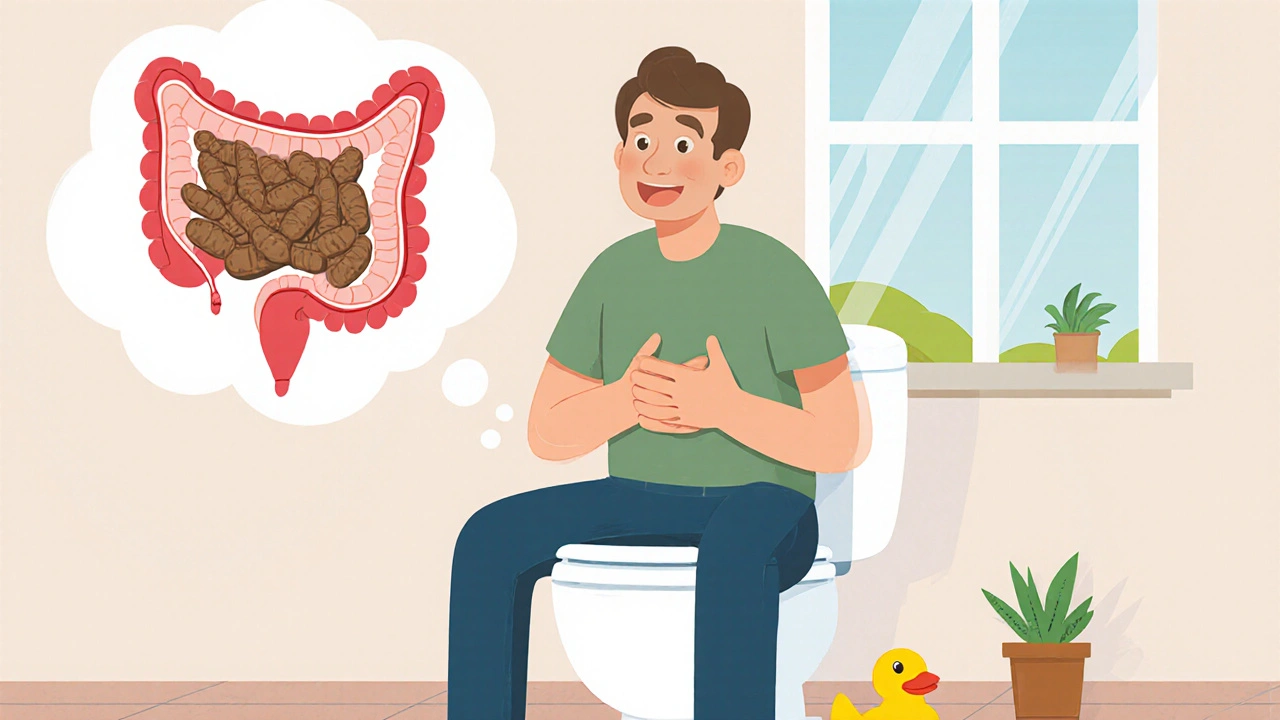When bowel movements become infrequent, hard, and painful, many people wonder if a simple over‑the‑counter pill can help. bisacodyl often pops up in that conversation, but how exactly does it work, and is it safe for long‑term use?
What is Functional Constipation?
Functional constipation is a common gastrointestinal disorder characterized by chronic infrequent stools, hard stool consistency, and straining without an underlying structural cause. It affects up to 15% of adults worldwide and is especially prevalent among older adults and those with sedentary lifestyles.
The condition typically stems from slowed colonic transit, reduced water absorption, or diminished motility signals from the nervous system. Because no organic blockage or disease is present, treatment focuses on lifestyle changes and targeted medication.
Bisacodyl: A Quick Overview
Bisacodyl is a synthetic stimulant laxative that has been on the market since the 1950s. It belongs to the class of stimulant laxatives, which trigger rhythmic contractions of the colon to propel stool forward.
When taken orally, bisacodyl is largely inert until it reaches the colon, where gut bacteria convert it into its active form, bis-(p‑hydroxyphenyl)‑pyridyl‑methane. This metabolite irritates the lining of the large intestine, prompting increased peristalsis and a mild secretory effect that draws water into the lumen.
How Does Bisacodyl Fit Into a Constipation Management Plan?
For many patients, the first line of defense against functional constipation involves diet, fluid intake, and exercise. When those measures fall short, bisacodyl offers a predictable, short‑acting boost.
- Onset of action: 6-12 hours for oral tablets, 15-30 minutes for rectal suppositories.
- Duration: Typically 12-24 hours, making it suitable for occasional use or as a night‑time aid.
- Availability: Sold without a prescription in most pharmacies and supermarkets, often labeled as “stool softener” or “laxative.”
Because it works directly on the colon, bisacodyl can be especially helpful for patients whose constipation is tied to slowed colonic transit rather than dehydration alone.

Dosage Guidelines and Forms
Bisacodyl comes in two main oral forms - tablets (usually 5 mg) and liquid drops - and a rectal form (suppository, 10 mg). Below are the typical adult dosing recommendations:
- Start with a low dose: a single 5 mg tablet taken with a full glass of water at night.
- If no movement occurs within 12 hours, a second 5 mg tablet may be taken.
- Do not exceed 15 mg per day (three tablets) unless directed by a physician.
- For rectal use, insert one 10 mg suppository into the rectum after a bowel movement, preferably before bedtime.
Children and elderly patients require lower doses; a pediatrician may prescribe 2.5 mg for children over 12 years, while seniors often start with 2.5 mg to avoid cramping.
It’s crucial to follow a clear schedule-using bisacodyl intermittently (e.g., 2-3 times per week) helps prevent the colon from becoming dependent on the stimulant effect.
When to Use Bisacodyl vs. Other Laxatives
Choosing the right laxative hinges on the underlying cause of constipation and the desired speed of relief. Below is a quick comparison of bisacodyl with two frequently mentioned alternatives.
| Agent | Mechanism | Onset | Typical Adult Dose | OTC Status | Common Side Effects |
|---|---|---|---|---|---|
| Bisacodyl | Stimulant - irritates colon, increases peristalsis | 6-12 hrs (tablet), 15-30 min (suppository) | 5 mg tablet; 10 mg suppository | Yes | Abdominal cramps, urgency |
| Senna | Stimulant - anthraquinone glycosides, similar colonic irritation | 6-12 hrs | 17.5-35 mg tablet | Yes | Cramping, electrolyte loss |
| Polyethylene glycol (PEG) | Osmotic - retains water in stool | 1-3 days | 17 g powder dissolved in 8 oz water | Yes (some brands prescription) | Bloating, nausea |
Bisacodyl shines when rapid relief is needed, whereas PEG is preferred for gentle, long‑term softening. Senna offers a middle ground but can be harsher on the bowel wall with prolonged use.
Potential Side Effects and Safety Considerations
Like any medication, bisacodyl isn’t free of drawbacks.
- Abdominal cramps: The stimulant action can cause uncomfortable spasms, especially at higher doses.
- Electrolyte imbalance: Frequent use may lead to loss of potassium, which can affect muscle function.
- Dependence risk: Over time, the colon may rely on the drug’s stimulus, reducing natural motility.
- Anticholinergic side effects: In rare cases, patients report dry mouth or blurred vision, reflecting the drug’s mild anticholinergic activity.
Patients with inflammatory bowel disease, intestinal obstruction, or severe dehydration should avoid bisacodyl unless directed by a gastroenterologist.
Pregnant or breastfeeding women should consult their doctor first; while animal studies show low risk, human data are limited.
Integrating Lifestyle Measures
Medication works best when paired with simple habit changes. Here’s a quick checklist:
- Drink at least 2 liters of water daily. Hydration softens stool and eases passage.
- Consume 25-30 g of dietary fiber each day from fruits, vegetables, whole grains, and legumes.
- Schedule a regular bathroom time-ideally after meals, when the gastrocolic reflex is strongest.
- Engage in light physical activity-walking 30 minutes a day can boost colon motility.
- If using bisacodyl, limit use to 2-3 times per week and rotate with an osmotic laxative like PEG for maintenance.
These steps reduce the need for higher doses and keep the colon functioning naturally.
When to Seek Professional Help
If you notice any of the following, it’s time to talk to a healthcare professional:
- Stool not passing after 48 hours of bisacodyl use.
- Severe abdominal pain, vomiting, or blood in the stool.
- Unexplained weight loss or anemia.
- Persistent constipation despite lifestyle changes and intermittent bisacodyl use.
A doctor may order tests such as colonoscopy, stool studies, or motility assessments to rule out organic disease.
Bottom Line: Is Bisacodyl Right for You?
If you’re dealing with occasional functional constipation and need a predictable, fast‑acting option, bisacodyl is a solid choice. Keep the dose low, use it intermittently, and pair it with plenty of fluids and fiber. For chronic cases, consider rotating with an osmotic agent and discuss long‑term strategies with your clinician.
How quickly can I expect a bowel movement after taking bisacodyl?
Oral tablets usually work within 6 to 12 hours, while rectal suppositories can produce a result in as little as 15 to 30 minutes.
Can I use bisacodyl every day?
Daily use is not recommended. Regular use can lead to dependence and may reduce the colon’s natural ability to contract. Limit it to 2-3 times a week or follow a doctor’s guidance.
Is bisacodyl safe for seniors?
Seniors can use bisacodyl, but they should start with a lower dose (2.5 mg) and monitor for cramps or electrolyte loss. A physician should review any chronic use.
How does bisacodyl differ from polyethylene glycol?
Bisacodyl is a stimulant laxative that triggers colonic contractions; polyethylene glycol is an osmotic agent that draws water into the stool. PEG works more slowly (1-3 days) and is gentler for long‑term use.
What should I do if I experience severe cramping?
Stop the medication, stay hydrated, and consider a milder osmotic laxative. If cramps persist or are accompanied by vomiting, seek medical attention.


10 Comments
Clinton Papenfus
Bisacodyl remains a staple in the OTC arsenal for functional constipation due to its rapid onset and predictable action.
Zaria Williams
i think the article leaves out how many folks actually misuse the drug, like taking it daily thinking it’ll fix everything lol.
the whole “intermittent” suggestion sounds like a marketing ploy to keep us buying more.
plus the diet tips are kinda basic, i’ve heard better from my grandma.
Tamara Tioran-Harrison
Indeed, one must commend the centuries‑old practice of irritating the colon to achieve relief; such elegance is truly admirable :)
kevin burton
Make sure to stay hydrated when using bisacodyl.
Max Lilleyman
Daily use? That’s a rookie mistake 🙄. Stick to the recommended schedule.
Brett Witcher
From a pharmacological standpoint, bisacodyl exemplifies a prototypical stimulant laxative, its mechanism of mucosal irritation precipitating coordinated peristaltic activity.
Terell Moore
Ah, the modern quest for bowel regularity, a testament to humanity’s perpetual struggle against its own physiology. We ingest a synthetic stimulant, trusting that a chemically induced spasm will liberate us from the tyranny of inertia. Yet, in doing so, we neglect the philosophical implication: are we not, in essence, outsourcing our innate peristalsis to a pill? The article touts “intermittent use” as a safeguard, but who decides the cadence of dependence? A day without the tablet becomes a day of anxiety, a silent reminder of the colon’s perceived inadequacy. One might argue that bisacodyl is merely a temporary bridge, but bridges are meant to be crossed, not dwelled upon forever. The comparison with polyethylene glycol reduces the discourse to a binary of speed versus gentleness, ignoring the subtle art of listening to one's gut. Moreover, the emphasis on electrolyte balance is commendable, yet the deeper issue is the cultural aversion to fiber, to movement, to the very act of sitting patiently. In a world where instant gratification reigns, why should we expect the bowels to adhere to a slower, natural rhythm? The article’s checklist reads like a to‑do list for a rabbit, not a sophisticated adult. If we truly respect our bodies, we would integrate mindful eating, regular ambulation, and perhaps a meditation on the void that precedes a bowel movement. Alas, the convenience of a tablet seduces us into complacency. The author’s counsel to rotate with osmotic agents is sound, but it also hints at a tacit admission of dependence. Thus, the moral of the piece is less about the drug and more about our collective unwillingness to endure modest discomfort for long‑term benefit. In the end, bisacodyl is a mirror reflecting our impatience, a reminder that sometimes, the simplest solutions are the most revealing.
Olivia Harrison
Thanks for the thorough overview! I’ve found that pairing bisacodyl with a high‑fiber breakfast really smooths out the rhythm, and staying consistent with water intake makes the difference.
Bianca Larasati
Picture this: you’re at the crack of dawn, a steaming bowl of oatmeal awaiting, and the gentle nudge of a bisacodyl tablet in the night-suddenly the whole day feels like a sunrise of possibility! It’s amazing how a small step can set the stage for a triumphant stride through your morning routine.
Corrine Johnson
One must, undoubtedly, consider, beyond the mere pharmacodynamics, the sociocultural ramifications, of relying on a stimulant laxative; indeed, the very act of delegating colonic function to a tablet, raises questions, about autonomy, about the body’s inherent wisdom, and about the perpetual human desire to circumvent natural processes.